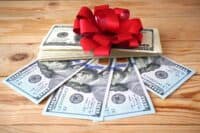
The words “profit down” are beginning to sound like a broken record for Canadian banks.
On May 24, the Bank of Montreal (CA:BMO) and Bank of Nova Scotia (CA:BNS) reported second-quarter 2023 (April-end) results. Both banks missed analyst expectations as a result of higher loan provisions.
With a possible recession in the second half of the year, the situation for banks will likely get worse before it gets better, suggesting that the best days for Canadian banks could be behind them.
As a group, the country’s bank stocks are down 7.3% in the last six months, as reflected in the performance of the Horizons Equal Weight Canada Banks Index ETF (CA:HEWB). That Toronto-listed exchange-traded fund holds all six of the country’s biggest lenders. BMO stock is down 14.6% in that time, while BNS stock is down 8%.
Fintel’s quant model dashboards currently show a Value score for BMO stock of 75.77 and for BNS of 63.32. Recall, those numbers are derived from a proprietary scoring model that ranks companies based on their relative valuation. Scores range from 0 to 100, with 100 being the most undervalued.
BMO’s Miss
BMO reported second-quarter adjusted earnings per share of $2.93, 30 cents lower than a year earlier and 26 cents less than the analyst estimate. (All figures in Canadian dollars, unless otherwise specified.)
Its reported revenue in the quarter was $8.44 billion, 9.4% lower than Q2 2022. On an adjusted basis, accounting for the Bank of the West acquisition (completed in February for US$13.8 billion) and higher net interest income, revenues rose 46.8% from $5.76 billion a year ago and flat to Q1 2023.
“Against the backdrop of an uncertain economic environment, our Canadian and U.S. personal and commercial banking businesses continued to deliver good pre-provision, pre-tax earnings, while our wealth and capital markets businesses were impacted by lower customer activity,” said Darryl White, chief executive officer, BMO Financial Group.
“These results were underpinned by continued strong asset quality and capital, with a CET1 ratio of 12.2% following the closing of the largest acquisition in our history.”
While both its U.S. personal and commercial banking (P&C) business and Canadian P&C grew their pre-provision pre-tax earnings (PPPT) in the quarter — 48.7% higher to US$858 million for the former and 7.4% higher to $1.42 billion for the latter – it is the bank’s provision for credit losses (PCL) that ought to be worrying investors.
The Canadian P&C segment had $228 million in PCL in Q2 2023, up from $164 million in Q1 2023 and $54 million in Q2 2022, a four-fold increase from a year ago. Its U.S. P&C segment PCL in the quarter was US$51 million, up from US$46 million in the previous quarter and a recovery of US$30 million a year ago.
Bank of Montreal’s total reported PCL in the quarter was $1.02 billion, up from $217 million in the previous quarter and $50 million a year ago.
Given Canadians have the highest household debt in the G7, bank investors in this country have to be somewhat worried about the second half of the year, regardless of the dividend increases provided by both banks.
What About BNS?
Bank of Nova Scotia’s revenue fell to $7.93 billion in the second quarter, $51 million less than in the first quarter, and $13 million less than a year ago, so it was essentially flat YOY. On the bottom line, its net income was $2.13 billion, or $1.69 a diluted share, down 20.1% from $2.67 billion, or $2.16.
The bank’s PCL in the quarter was $709 million, $71 million higher than the previous quarter and 223.7% up from $219 million a year ago. For the first six months of the year, its PCL increased by 205.4% to $1.35 billion from $441 million a year ago.
On a per-share basis, the bank’s $1.69 in earnings were eight cents lower than the consensus estimate.
“I am pleased with the bank’s stable operational performance in the quarter and encouraged that our strong capital and liquidity profile positioned us well to manage through the current environment of heightened macroeconomic uncertainty,” Scotiabank chief executive Scott Thomson said in a statement.
Like BMO, BNS increased its quarterly dividend by 2.9% to $1.06 a share. Its annualized payment of $4.24 yields a high 6.5%.
Nothing soothes the nerves of bank investors like a dividend hike. But, while it’s important not to get carried away by the latest results, a perfect storm between high Canadian household debt and lower economic output could be brewing.
That spells trouble for the Big Five and all the other Canadian banks.
This article originally appeared on Fintel
It’s Your Money, Your Future—Own It (sponsor)
Retirement can be daunting, but it doesn’t need to be.
Imagine having an expert in your corner to help you with your financial goals. Someone to help you determine if you’re ahead, behind, or right on track. With SmartAsset, that’s not just a dream—it’s reality. This free tool connects you with pre-screened financial advisors who work in your best interests. It’s quick, it’s easy, so take the leap today and start planning smarter!
Don’t waste another minute; get started right here and help your retirement dreams become a retirement reality.
Thank you for reading! Have some feedback for us?
Contact the 24/7 Wall St. editorial team.





